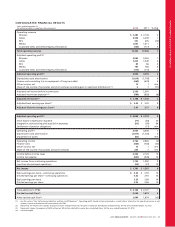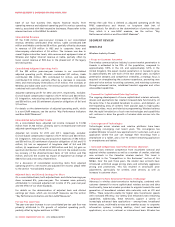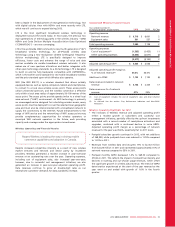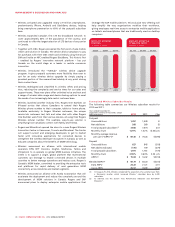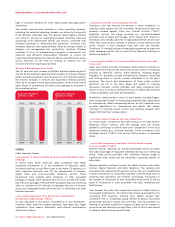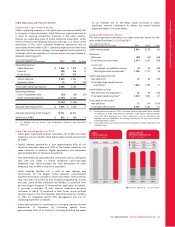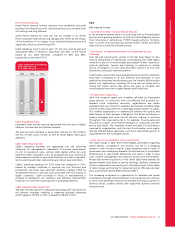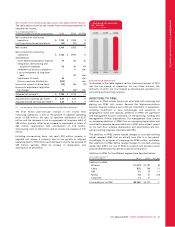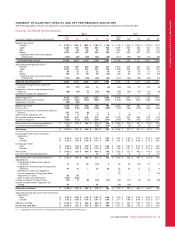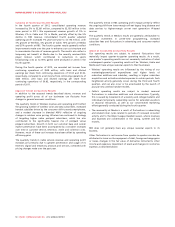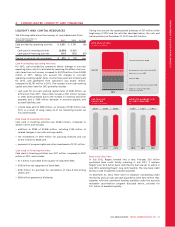Rogers 2012 Annual Report Download - page 45
Download and view the complete annual report
Please find page 45 of the 2012 Rogers annual report below. You can navigate through the pages in the report by either clicking on the pages listed below, or by using the keyword search tool below to find specific information within the annual report.
MANAGEMENT’S DISCUSSION AND ANALYSIS
Home Phone Revenue
Home Phone revenue includes revenues from residential and small
business local telephony service, calling features such as voicemail and
call waiting, and long-distance.
Home Phone revenue for 2012 was flat. An increase in our Home
Phone subscriber base and pricing changes were offset by the impact
of the divestiture of our legacy circuit switched telephony base and
operations, which occurred during 2011.
Cable telephony lines in service grew 2% last year, and by year-end
represented 49% of Television subscribers and 28% of the homes
passed by our cable networks, compared to 46% and 28%,
respectively, at the end of 2011.
(In thousands)
CABLE TELEPHONY SUBSCRIBERS
AND PENETRATION
OF HOMES PASSED
1,003 1,052 1,074
2010 2011 2012
27% 28% 28%
Cable Equipment Sales
Equipment sales include revenues generated from the sale of digital
cable set-top terminals and Internet modems.
The year-over-year decrease in equipment revenue for 2012 reflects
the mix of sales versus rentals, as well as fewer digital cable gross
additions.
Cable Operating Expenses
Cable’s operating expenses are segregated into the following
categories for management’s assessment of business performance:
(i) cost of equipment sales, namely cable digital set-top box and
Internet modem equipment costs; (ii) programming costs; and (iii) all
other expenses incurred to operate the business on a day-to-day basis,
service existing subscriber relationships and attract new subscribers.
Cable’s operating expenses for 2012 were flat compared to 2011,
helped by strategic initiatives to improve our cost structure and
productivity and lower new subscriber additions, partially offset by
incremental retention costs and costs associated with the analog to
digital conversion. Cable continues to focus on implementing a
program of permanent cost reduction and efficiency improvement
initiatives to control the overall growth in operating expenses.
Cable Adjusted Operating Profit
The year-over-year growth in adjusted operating profit was driven by
the revenue increases, resulting in expanded adjusted operating
profit margins of 47.8% in 2012, compared to 46.8% in 2011.
RBS
RBS Industry Trends
> Growth of Internet Protocol-Based Services
In the enterprise market, there is a continuing shift to IP-based based
services and a growing adoption of VoIP and cable telephony services
from time-division multiplexing (“TDM”) based protocols. Similarly,
there is a shift from asynchronous transfer mode (“ATM”) and frame
relay services to Ethernet IP-based services.
> Investment in Improved Networks and Expanded Service
Offerings
Over the past several years, carriers of all sizes have begun to lean
towards dismantling or significantly consolidating their TDM legacy
networks in favour of more reliable and scalable IP Next Generation
network platforms. Carriers are investing in networks to enable
service convergence of voice, data and video solutions all onto one
distribution and access network platform.
Traditionally, services that were separated across monolithic platforms
have been converging to IP and Ethernet and examples of such
applications have been proliferating across the industry. RBS launched
several such applications, including SIP voice services along with a
Virtual Call Centre service that allows end users to virtualize and
consolidate services over a single Ethernet and IP platform.
> Proliferation of Big Data
With the increased speed and reliability afforded by fibre-based
access services, in conjunction with cost effective and powerful on-
demand cloud computing resources, organizations are better
equipped than ever before to assemble and analyze incredibly large
volumes of data captured from a seemingly endless number of inputs.
This enables organizations to dramatically enhance the quality and
effectiveness of their business intelligence. This allows businesses to
analyze strategies and drive tactical decision making in real-time
throughout the organization, be it, for example, focusing sales and
resources to support micro-market strategies or improving customer
service and loyalty. The increased volume and detail of information
captured by organizations, and the rise of multimedia, social media,
and the Internet-based applications will drive exponential growth in
data demand for the foreseeable future.
> Data Centre Consolidation and Virtualization
The rapid change in data centre technologies, particularly regarding
power density, virtualization and security, has led to a changing
dynamic in the colocation market. Large enterprises and all levels of
government are undergoing dramatic transformations to consolidate
infrastructure to gain better efficiencies and scale in order to save
costs, simplify management and improve security and performance.
Recent data centre acquisitions in the carrier space have enabled far
greater breadth and depth of service offerings. Similarly, enterprise
solution requirements are moving into the physical and virtual realm
of data storage and hosting for advanced service offerings like IaaS,
SaaS, and Software Defined Networking (“SDN”).
The increasing acceptance in organizations to embrace and model
virtualization through the proliferation of cloud services will continue
to drive more advanced network functionality and require carriers to
develop robust, scalable services and supportive dynamic network
infrastructures.
2012 ANNUAL REPORT ROGERS COMMUNICATIONS INC. 41




